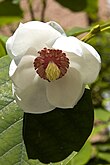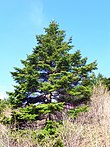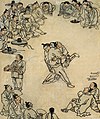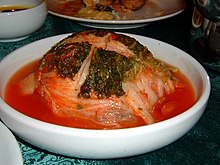
The national flag of the Democratic People's Republic of Korea, also known as the Ramhongsaek Konghwagukgi, consists of a central red panel, bordered both above and below by a narrow white stripe and a broad blue stripe. The central red panel bears a five-pointed red star within a white circle near the hoist.

Kimjongilia is a flower named after the late North Korean leader Kim Jong Il. It is a hybrid cultivar of tuberous begonia, registered as Begonia × tuberhybrida 'Kimjongilhwa'. When Kim Jong Il died in December 2011, the flower was used to adorn his body for public display. Despite its name, the Kimjongilia is not the official national flower of North Korea, which is the Magnolia sieboldii. Another flower, Kimilsungia, is an orchid cultivar named after Kim Jong Il's father and predecessor, Kim Il Sung.
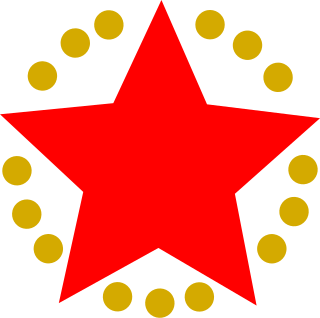
The Supreme People's Assembly is the highest organ of state power of North Korea. It is the only branch of government in North Korea, and per the principle of unified power, all state organs are subservient to it. It consists of one deputy from each of North Korea's 687 constituencies, elected to five-year terms.

The emblem of North Korea is a national symbol adopted in 1993. Its design is modified from the former version in use from the founding of North Korea in 1948. Prominent features on the emblem are a red star, a hydroelectric plant and Mount Paektu. The design bears similarities to the emblem of the Soviet Union and other emblems of the socialist heraldic style.

Kim Jong Suk was a Korean anti-Japanese guerrilla, a Communist activist, North Korean leader Kim Il Sung's first wife, former leader Kim Jong Il's mother, and current leader Kim Jong Un's grandmother.

The General Federation of Trade Unions of Korea is the sole legal trade union federation in North Korea. GFTUK was formed on November 30, 1945 as the General Federation of Trade Unions of North Korea. In January 1951, it was reorganized and adopted its current name. The chairman of the central committee of GFTUK is Pak In-chol.
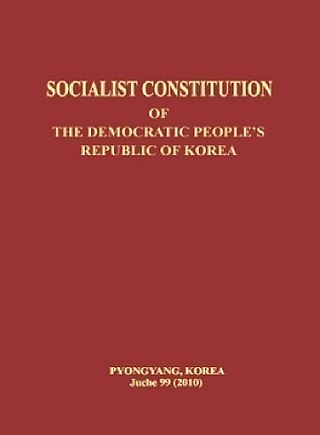
The Socialist Constitution of the Democratic People's Republic of Korea is the constitution of North Korea. It was approved by the 6th Supreme People's Assembly at its first session on 27 December 1972, and has been amended and supplemented in 1998, 2009, 2012, 2013, 2016, 2019 (twice), and in 2023. It replaced the country's first constitution which was approved in 1948.
The award system of the Democratic People's Republic of Korea was initially created less than one month after the foundation of the Republic. During the years of Japanese occupation of Korea, many of the future leaders fled to the Soviet Union. During World War II many if not close to all party leaders and Korean People's Army commanders served in the Soviet Army and as such adopted many of the Soviet awards criteria for their own. During the late 1940s and until the Sino-Soviet Split in late 1958, orders and titles were made in the Soviet Money Mints in Moscow or Leningrad. Soviet made awards were modeled after Soviet orders and made of sterling silver. Initially the orders were attached to clothing with a screw-plate, but after Soviet production stopped, production was moved to North Korea. The screwback was replaced with a pin and the silver content was replaced with cheap tin. With the exception of a few examples of modern orders, Soviet and Czech KPA awards are the most sought after in current militaria markets.

Kim Won-gyun was a North Korean composer and politician. He is considered one of the most prominent, if not the most celebrated, composer of North Korea. He composed "Aegukka" — the national anthem of the country — and "Song of General Kim Il-sung", in addition to revolutionary operas.
The People's Prize is a North Korean arts and sciences award. It is awarded by the People's Prize Awarding Commission, which is working directly under the Cabinet of North Korea. The prize can be granted to works of art or people. People's Prize has been an important award in the field of North Korean cinema.
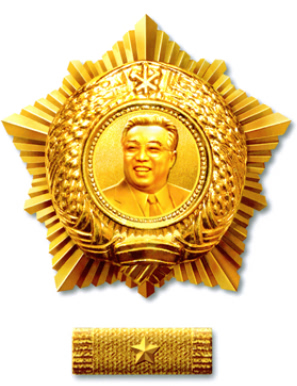
The Order of Kim Il Sung (Korean: 김일성훈장) is the highest order of North Korea, along with the Order of Kim Jong Il, and only second to one honorary title, the Hero of Labour.

The Order of Kim Jong Il is a North Korean order named after Kim Jong Il, the former leader of North Korea. It is the highest order of North Korea, along with the Order of Kim Il-Sung, and only second to one honorary title, the Hero of Labour.
The Kim Il Sung Prize (김일성상) is an award given by the Government of North Korea to persons in various fields who demonstrate exemplary service to the values of Juche idea. Past winners include the Korean composer Kim Won-gyun, judoka Kye Sun-hui, and the Arirang Festival.

The Day of the Shining Star is a public holiday in North Korea falling on 16 February, the anniversary of the birth of the country's second leader, Kim Jong Il. Along with the Day of the Sun, the birthday of his father Kim Il Sung, it is the most important public holiday in the country.
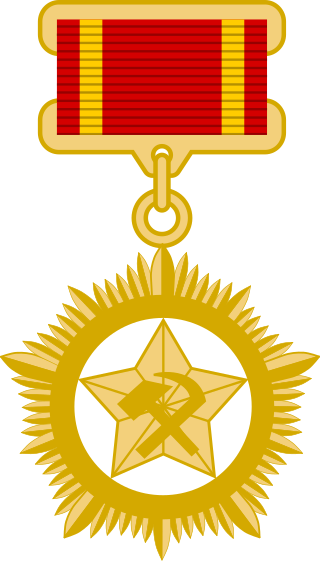
Labor Hero is one of the highest titles of honor of North Korea and the highest decoration of the country overall. The award was probably scheduled for establishment in the summer of 1950, but the Korean War postponed these plans. When the war had entered a phase of stalemate along the 38th parallel, the government had time to officially launch the decoration, originally under the name Korea Hero of Labor. 16 people were decorated Labor Heroes during the war and more since then. The decoration is based on its Soviet equivalent, Hero of Socialist Labour.

The State Affairs Commission of the Democratic People's Republic of Korea (SAC) is constitutionally the supreme political authority of North Korea. The State Affairs Commission was created by 2016 amendments to the North Korean Constitution to replace the previously military-dominated National Defence Commission.
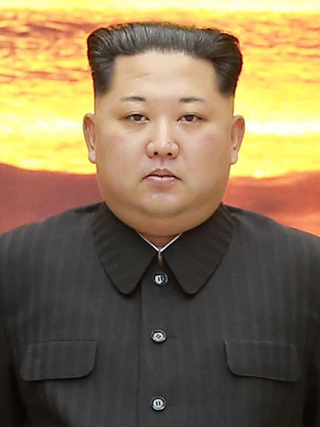
Kim Jong Un has been the supreme leader of North Korea since the death of Kim Jong Il in 2011.
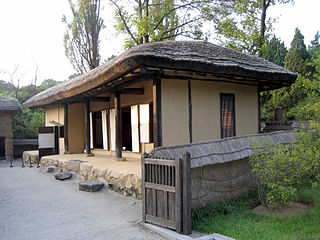
Revolutionary Sites (Korean: 혁명사적지) are designated historical sites in North Korea. The sites were designated by Kim Jong Il when he began working at the Propaganda and Agitation Department of the Workers' Party of Korea in 1966. He would send troops all over the country to unearth sites that "were supposedly once forgotten and undiscovered". By converting North Korea into a "huge open museum", Kim's goal in designating the sites was to solidify the North Korean cult of personality centered around him and his father Kim Il Sung.
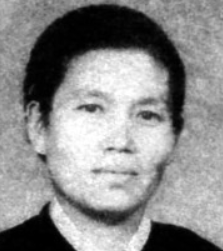
Ri Yong-suk was a North Korean politician and revolutionary. A veteran of the anti-Japanese struggle, Ri had close relations with all three generations of the Kim dynasty. During WWII, she was with Kim Il Sung in the Soviet 88th Separate Rifle Brigade. During the Korean War, she took care of Kim Jong Il, eldest son and future heir of Kim Il Sung. Under Kim Jong Un, she was portrayed as a link between the original guerrilla generation and the current leadership. Ri was elected to the Supreme People's Assembly in 1998 and 2003.




